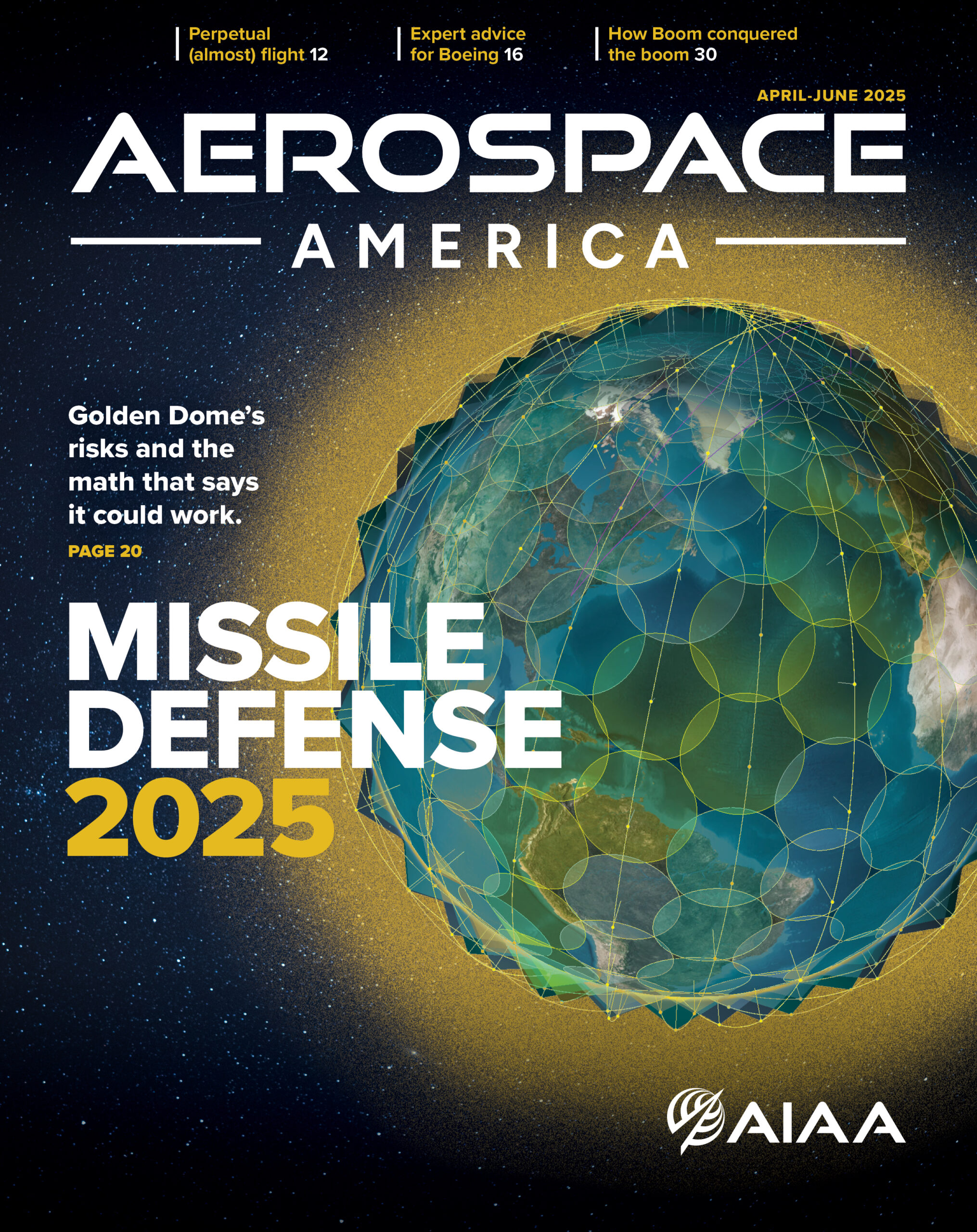Stay Up to Date
Submit your email address to receive the latest industry and Aerospace America news.
Humanity can’t advance without big ideas, but big ideas can’t become reality without sound economic underpinnings and a bit of courage. Dennis M. Bushnell explains.
One definition of a big idea is a concept or approach that upends conventional beliefs and behaviors and perhaps disrupts markets on a grand scale. As we have shifted from the Industrial Age to the Information Age, moving rapidly now into the Virtual Age, we have shifted from creating wealth by exploiting natural resources to doing so via creativity and invention. This shift amplifies the economic importance and impacts of big ideas. The Harvard Business School states that “big ideas rank high on a list including technology and intellectual property as sources of competitive advantage.”
The ongoing development of renewable energy is an example of the criticality of favorable economics for big idea adoption. Although renewable energy approaches are absolutely necessary for climate change mitigation, their development began slowly. Eventually, a combination of improvements in device efficiency, manufacturing approaches and economies of scale brought the costs of this energy nearly to that of the energy derived from fossil fuels, then to parity and then below the costs of conventional fuels in some 65% of the world. These cost reductions have greatly accelerated the growth of renewable sources of energy, far in excess of previous estimates. Renewables now comprise 65% of new generation capacity and 25% of the world’s electricity, with ever lower year-on-year costs of generation and storage. Nuclear and coal plants are closing. These cost reductions created favorable economics for transitioning electrical generation to renewables. In this process, energy costs are declining, employment is increasing, climate is mitigated, large numbers are spared a premature death from fossil fuel pollution, and electric aircraft will be recharged with green energy. Also, as all of transportation goes electric, as the batteries improve and we reduce aircraft drag and weight, petroleum as a heavy transportation fuel loses prominence.
There are now two ongoing aerospace big idea revolutions, each with prospective overall market projections in the trillion-dollar range, which should produce a renaissance in aerospace.
Going airborne
One big idea calls for replacing much of today’s ground transportation with aircraft. The first step in this revolution centers on uninhabited air systems, or UAS. These aircraft will perform a plethora of societal services, including searching for stranded hikers or boaters; photographing real estate; monitoring pipelines and power lines; delivering consumer packages; and surveilling crime scenes for law enforcement officers. Also coming is on-demand mobility, or ODM for short. These aircraft will pick up and drop off passengers without scheduled flights. For scheduled service, urban air mobility aircraft will replace today’s bus and train services. Personal air vehicles will replace automobiles, and these PAVs, in fact, are the largest prospective market. Operating to and from your driveway or street, they would largely obviate traffic tie-ups and, if autonomous, save lives due to reduced traffic accidents. They would mitigate the tremendous infrastructure costs associated with upgrading and maintaining roads and bridges.
The primary enabling technologies for all these classes of vehicles include information technology and artificial intelligence combined with miniaturization and economies of scale and print manufacturing to reduce costs. Numerous companies in the U.S. and abroad now hope to achieve the ultimate vision of flying safe and affordable electrically powered vertical-takeoff-and-landing craft.
Reaching space affordably
The other big idea calls for an order-of-magnitude reduction in the cost of space access. A key enabler is the ongoing effort to create fully reusable rockets. Additional cost reductions would be proffered by incorporating autonomy, artificial intelligence and robotics not just in operating the rockets but in manufacturing them. This would reduce the labor costs that drive much of the high cost of space access. Fuel, for example, makes up less than 1% of space access costs. Addressing manufacturing costs would clear the way for commercializing deep space, establishing colonies and conducting safer, more reliable missions to the moon and Mars, including human missions. Commercial activities in space would no longer end with communications satellites in geosynchronous equatorial orbit. Faster transit times as well as powered entry, descent and landing would be enabled by the availability of low-cost space access. All told, this big idea provides serious economic improvements.
Welcoming creativity
Big ideas are usually longer term, more strategic, broader in scope and enabled by an organizational creative culture. The elements of a creative culture include masses of information, which studies of how humans ideate indicate the subconscious supposedly uses to form and then evaluate quasi-random combinations. When it finds a combination it likes, the subconscious reports back to the conscious when it is not otherwise engaged; walking and when waking up are usual subconscious feedback opportunities. Other creative culture elements include well-defined critical goals, risk embracing, perseverance, independence, multiple solution spaces and triage, toleration of questioning, adequate resources and awards. And, of course, the leaders in particular must also have courage and foresight.
Nascent big ideas and their supporting technologies that are under study at low technology-readiness levels include machine ideation, creativity via an approach similar to that of the subconscious. Machine learning pioneer Stephen Thaler created the “Imagination Engine,” wherein he trains a neural net and then isolates this network, lets it “dream,” producing quasi-random combinatorials, which are recorded and evaluated systemwise for various applications. This is not creational AI, but rather computational rapid brute force triage of a large number of possibilities. As this technique is developed further it would perhaps be capable of dealing with unknowns, a major need on the road to trusted autonomy, including in the aviation world. Trusted autonomy would reduce costs and vulnerability to the human factors that are a major cause of safety problems in aeronautics.
Another nascent technology for support of aerospace big ideas would be to apply silicon crystals to passively redirect galactic cosmic radiation away from space travelers or colonists. These crystals have been used for some four decades by the particle accelerator community to redirect up to tera electron volts energy level particles. The millimeter size of these crystals suggests they could even be incorporated into spacesuits to mitigate galactic cosmic radiation. This radiation is quite possibly the greatest hurdle to long-term human space travel and colonization, so this would be an enabler for the big idea of human colonization of Mars.
Then there is the issue of electrical power. The astronauts will need this for in-space propulsion and for on-body transportation at Mars or its moons; to drive the life support equipment on these vehicles and in their planetary habitat; and for in-situ resource utilization.
Revolutionary technology options to replace chemical fuels and solar include positrons, which proffer complete mass to energy conversion, some nine orders of magnitude greater energy density than chemical. The major breakthrough requirement for positrons as an energy source in space is long-term storage, with the state of the art at up to 1,000 minutes.
Another energy storage breakthrough is the NASA nuclear battery technology, called nuclear thermionic avalanche cells, invented by Sang Choi, a senior scientist at NASA’s Langley Research Center in Virginia. Nuclear engineers describe the weight efficiency of a nuclear device with a value called the alpha number, defined as how many kilograms of isotope and equipage are needed to produce a kilowatt of power. NTAC has an alpha near 1, compared to values in the 20s for nuclear reactors. This means NTAC is much more weight efficient. Also, NTAC has an energy density of 22 kilowatts/kg of isotope, which is orders of magnitudes higher than energy densities of radioisotope thermal generators. Overall, NTAC is far lighter than reactors and produces far more power than other nuclear battery designs.
NTAC would enable high thrust magnetohydrodynamic propulsion at some 6,000 seconds of specific impulse, a measure of fuel economy, enabling 200-day round trips for a human mission to Mars.
Then there is printing at the nanoscale to produce stable material microstructure to improve various material properties by projected factors of 5 to 10. This would result in lightweight payloads and rockets and therefore greater payload fraction. This material revolution will contribute greatly to inexpensive space access and the big idea of human colonization of Mars among other breakthroughs.
A renaissance in aerospace has begun, thanks to new technologies and leaders in the aerospace industry with the foresight and courage to exploit them. The endgame could well be an ultimate shift to personal air transportation and development of commercial deep space and human space colonization. Despite this progress, today innovators continue to encounter a “valley of death” defined as a shortage of support for concepts at technology readiness levels of 2ish to 4ish, far short of flight readiness. This is understandable, as this is the range where risk is largely retired and evaluated and where investors tend to be risk averse. However, usually there are great learning opportunities in this technology readiness level range, and to the extent creative ideas are allowed to languish and perhaps not be evaluated, many big ideas and their tremendous monetary and other benefits are delayed. Also, many ideas and technologies are delayed because either the enabling technologies or the markets or both were not present. That’s why it’s always useful to take a fresh look at old ideas given advances in technologies and the changing demands within markets. Reusable rockets were studied and tried experimentally before industry over the past decade took up the task, but the technologies and the requisite support and perseverance were not present. They apparently are in place now.
After many decades of far more evolutionary than revolutionary developments, aerospace — thanks to industrial courage, investments and foresight, the pursuit of big ideas and the ongoing technology revolution — is now on a path to reinvent itself and double market value on both the aero and space sides. Given the major worldwide shifts in economics, the flat technology landscape and the large percentage of research now conducted outside the U.S., this ongoing aerospace renaissance is an object lesson that to compete going forward requires big ideas. As stated, we now create wealth by ideation and invention.
Dennis M. Bushnell
is the chief scientist at NASA’s Langley Research Center in Hampton, Virginia.
Innovators continue to encounter a “valley of death” defined as a shortage of support for concepts in the range where risk is largely retired and evaluated and where investors tend to be risk averse.
Dennis M. Bushnell
Stay Up to Date
Submit your email address to receive the latest industry and Aerospace America news.




